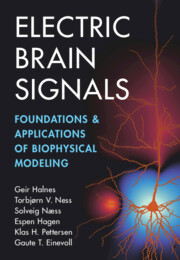Book contents
- Frontmatter
- Dedication
- Contents
- Preface
- Reserved Physical Symbols and Quantities
- Abbreviations
- 1 Introduction
- 2 Charges, Currents, Fields, and Potentials in the Brain
- 3 Neural Dynamics
- 4 Volume-Conductor Theory
- 5 Conductivity of Brain Tissue
- 6 Schemes for Computing Extracellular Potentials
- 7 Spikes
- 8 Local Field Potentials (LFPs)
- 9 Electroencephalography (EEG)
- 10 Electrocorticography (ECoG)
- 11 Magnetoencephalography (MEG)
- 12 Diffusion Potentials in Brain Tissue
- 13 Final Comments and Outlook
- Appendix A Frequency-Dependent Length Constant
- Appendix B Derivation of the Current-Dipole Approximation
- Appendix C Electric Stimulation
- Appendix D Derivation of the Point-Source Equation for Anisotropic Medium
- Appendix E Statistical Measures
- Appendix F Fourier-Based Analyses
- Appendix G Derivation of Formulas for Population Signals
- Appendix H Equations for Computing Magnetic Fields
- Appendix I Derivation of the MC+ED Scheme
- References
- Index
2 - Charges, Currents, Fields, and Potentials in the Brain
Published online by Cambridge University Press: 30 May 2024
- Frontmatter
- Dedication
- Contents
- Preface
- Reserved Physical Symbols and Quantities
- Abbreviations
- 1 Introduction
- 2 Charges, Currents, Fields, and Potentials in the Brain
- 3 Neural Dynamics
- 4 Volume-Conductor Theory
- 5 Conductivity of Brain Tissue
- 6 Schemes for Computing Extracellular Potentials
- 7 Spikes
- 8 Local Field Potentials (LFPs)
- 9 Electroencephalography (EEG)
- 10 Electrocorticography (ECoG)
- 11 Magnetoencephalography (MEG)
- 12 Diffusion Potentials in Brain Tissue
- 13 Final Comments and Outlook
- Appendix A Frequency-Dependent Length Constant
- Appendix B Derivation of the Current-Dipole Approximation
- Appendix C Electric Stimulation
- Appendix D Derivation of the Point-Source Equation for Anisotropic Medium
- Appendix E Statistical Measures
- Appendix F Fourier-Based Analyses
- Appendix G Derivation of Formulas for Population Signals
- Appendix H Equations for Computing Magnetic Fields
- Appendix I Derivation of the MC+ED Scheme
- References
- Index
Summary
Readers who do not have strong schooling in physics can consult this book chapter for an introduction to key concepts such as ion fluxes, electric fields, electric potentials, and electric currents as well as for definitions of the ohmic, electrodiffusive, and capacitive currents that govern the electrodynamics of brain tissue. Building on the biophysical principles and approximations introduced here, we explain how the electric potential surrounding neurons can be computed based on the principles of current conservation and electroneutrality, and wegive a brief overview of modeling schemes designed to perform such computations on computers. Towards the end of the chapter, we show how the standard theory for computing extracellular potentials relates to Maxwell’s equations and list the approximations that we typically make when we apply these equations in a complex medium like brain tissue.
Keywords
- Type
- Chapter
- Information
- Electric Brain SignalsFoundations and Applications of Biophysical Modeling, pp. 11 - 40Publisher: Cambridge University PressPrint publication year: 2024



